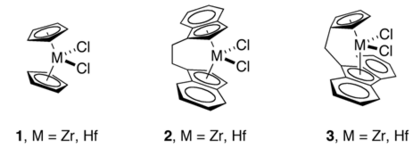Kaminsky catalyst
[1] Kaminsky catalysts are based on metallocenes of group 4 transition metals (Ti, Zr, Hf) activated with methylaluminoxane (MAO).These and other innovations have inspired development of new classes of catalysts that in turn led to commercialization of novel engineering polyolefins.[3][4] Prior to Kaminsky's work, titanium chlorides supported on various materials were widely used (and still are) as heterogeneous catalysts for alkene polymerization.The MAO serves two roles: (i) alkylation of the metallocene halide and (ii) abstraction of an anionic ligand (chloride or methyl) to give an electrophilic catalyst with a labile coordination site.[1][5] Kaminsky's discovery of well-defined, high activity homogeneous catalysts led to many innovations in the design of novel cyclopentadienyl ligands.

catalytic systemalkenepolymerizationmetallocenestransition metalsmethylaluminoxaneconstrained geometry organotitanium complexWalter KaminskytrimethylaluminiumZiegler–Natta catalystsansa-metallocenesconstrained geometry catalystschiralcyclopentadienylα-olefinsatacticpolypropylenesymmetricisotacticsyndiotacticChem. Rev.